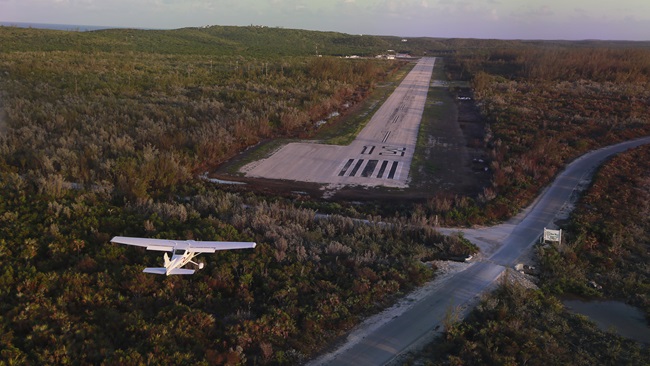Drop and plop
The short-field landing isn’t lovely—and it isn’t supposed to be
A greaser. Isn’t that what we strive for? The airspeed spot on, the flare just so, the gentle chirp-chirp of the tires on the runway that lets you know you pulled it off. It’s a thing of beauty.

Then there’s the short-field landing. No awesome nickname, little to no flare, no squeak of the tires. If a regular landing is a fluid sequence of events leading to a graceful denouement, a short-field landing is a balancing act: Land as slowly as you can manage, so you can touch down on a specific point.
Recall that the short-field approach and landing to airman certification standards requires the pilot to select and aim for a suitable touchdown point considering the wind, landing surface, and obstructions. In this task, the pilot must establish the recommended approach and landing configuration and airspeed, and adjust pitch attitude and power as required to maintain a stabilized approach.
The goal is not only to land on a specific point, but to do so in a way that lets you avoid an obstacle at the approach end of the runway—power lines or trees in most instances, although these types of obstacles conveniently located at the approach end of a runway aren’t as prevalent as they once were.
 Many students struggle with the short-field landing. They understand the objective—put it down on a specific point—but can’t correctly manage energy and airspeed to make that happen. Or, they try to accomplish that objective as they would a regular landing, albeit at a slower landing speed—and trying to flare. Surely that will work?
Many students struggle with the short-field landing. They understand the objective—put it down on a specific point—but can’t correctly manage energy and airspeed to make that happen. Or, they try to accomplish that objective as they would a regular landing, albeit at a slower landing speed—and trying to flare. Surely that will work?
It won’t. The short-field landing can’t be executed like a regular landing. Here’s where the “drop and plop” mechanism comes into play.
Coined by CFI Tamara Griffith, “drop and plop” is an unlovely but accurate descriptor for the short-field landing. “It’s not a pretty landing, but functional,” she said.
She teaches it by first locating an airport with an obstacle near the runway, or at least in the line of sight to that runway. “They can see it and then chop that power, [set] minimum speed, and lower that nose immediately,” said Griffith, who instructs at Fox Aviation International in Denton, Texas.
Approach speed
What is the correct approach speed for a short-field landing? It varies by airplane. The recommended approach speed and flap configuration for a short-field landing is in your pilot’s operating handbook. If there is no recommended approach speed, use the Airplane Flying Handbook’s recommended formula: Take your airplane’s stall speed with power off, and flaps and landing gear extended, and multiply that by 1.3.
The final approach speed is lower than students are used to flying; seeing the airspeed needle at the very bottom of the white arc may be unnerving. That’s OK, said CFI Tom Zecha, who is AOPA’s senior manager of the Pilot Information Center: “You won’t stall.”
Although you’re constrained by the amount of runway you can use upon landing, you can certainly create a wider pattern to give yourself more time to get properly set up.
Aiming point and touchdown point
If a stripe in the runway is your touchdown point, your aiming point needs to be 100 or so feet in front of that—runway numbers work well in this instance as an aiming point.
Use a dry-erase marker to help you center the numbers (or whatever aiming point) in your airplane’s windshield, then use that sight reference on your approach. If you see the numbers move up, you’re too low; if they move down, you’re too high.
Don’t become wedded to one touchdown point. Try several, on several different runways. Your designated pilot examiner may choose a point for you, and if you become too used to one point it could affect your technique.
Touchdown
Nailing the approach airspeed is critical. Carrying extra airspeed to your intended touchdown point almost certainly means you will float well past it. On a no-wind day, for every knot over that airspeed, you may float 100 feet past your touchdown point, Griffith said. Headwinds or gusts can help mitigate that additional energy, but if you should carry too much and try to flare, the airplane will balloon up.
“It’s a hard landing,” said Griffith. “You gotta be ready for it.” And, she acknowledged, “drop and plop” can be hard on some airplanes. “But if you watch a STOL [short takeoff and landing] airplane, that’s what it does.” The Airplane Flying Handbook agrees with her: “The short-field approach and landing is in reality an accuracy approach to a spot landing.”
The roundout and flare is almost a single motion, Zecha added.
At touchdown, you’re landing at such an airspeed as to allow little to no energy to do a proper flare. That’s OK—again, the finesse of a flare is not the point of this landing. Stopping as soon as possible is the point. “Sometimes it takes a nice, calm day to make it all click,” Griffith said.
Once you touch down, use heavy braking but do not lock the brakes. Zecha said he teaches students to use full aft elevator once braking has begun to assist in slowing down the airplane.
Go around
You should be prepared for a go-around on any approach and landing, but it’s particularly critical when practicing a short-field landing. If you are landing on an actual short field and you miss your intended touchdown point, you risk running off the end of the runway, or worse.
“The first time I sense any kind of float, I have them power up and go around,” said Zecha. “[Students] try to save that landing when they’re bleeding airspeed and you’re eating up runway. If it’s an actual short runway you could have real trouble, real quick.”
Zecha said things to watch for include seeing your aim point passing underneath you, or an inability to make the roundout to flare be a single, smooth motion. “Just make the go-around decision,” he said.
Once you’ve practiced on your home field, it’s time to visit a short runway with your CFI. Picture yourself at a STOL competition and show off your best technique. You won’t get YouTube views, but you will become more practiced at this most interesting type of arrival.



